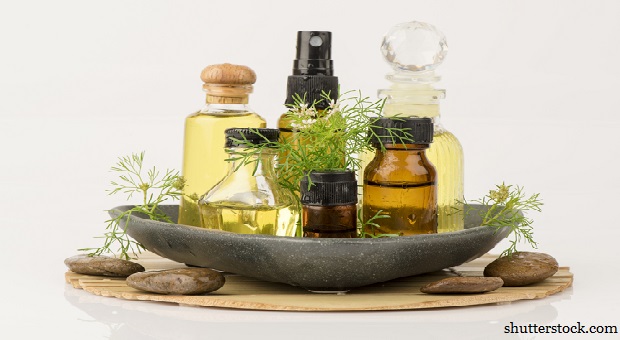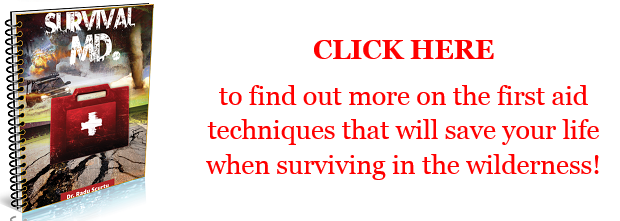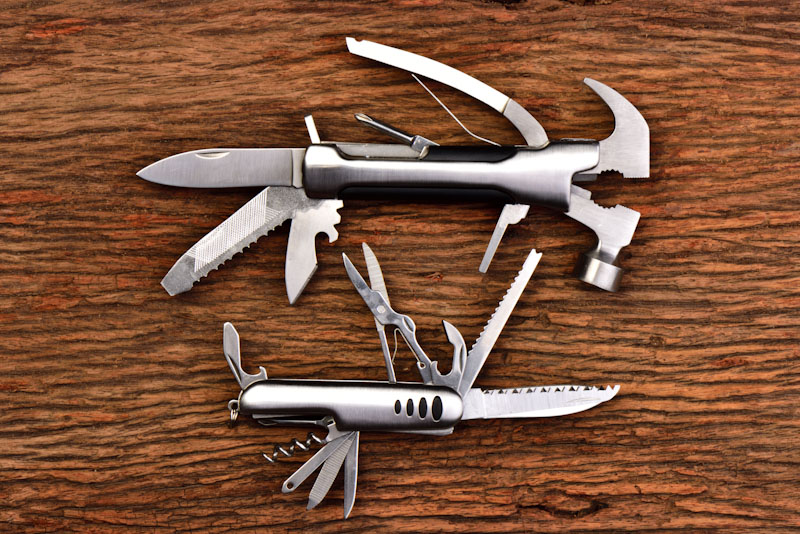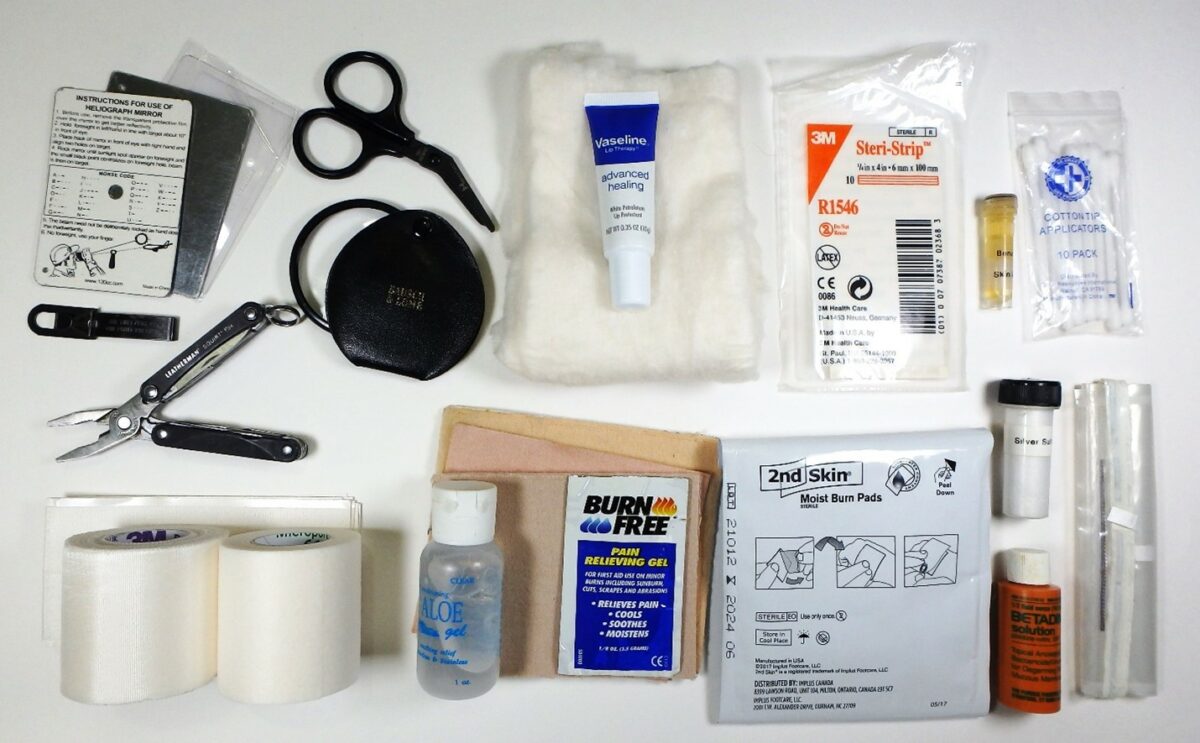As an avid reader of survival readiness material, you likely possess a cognizant recognition for the value of living the preparedness lifestyle. You’re undoubtedly aware, survival living is both intentional and quite purposeful. Disasters often occur unexpectedly and without warning.
Mother nature doesn’t discriminate between young or old – rich or poor.
So, when it comes to your family’s health in times of crises, the survivalist in you knows how vital preparedness is. Imagine living without the knowledge of what to do when there’s no way to leave your home and your child has an asthma attack. Without an inhaler, how do you open his airways?
What if someone is cut and the wound develops an infection? Without quick access to emergency medical care, how should this situation be handled?
Stress and anxiety are the most common, yet underrated symptoms nearly everyone experiences in times of disaster. Have you kept your skillset sharp in order to keep yourself and your family calm and focused?
These are all questions to stay abreast of – ahead of disaster, so that when disaster occurs, you know that with the solutions you have on hand, you can relax and handle your family’s health needs as a champion of self-reliance.
In today’s blog, we will discuss holistic healing and oils – their many uses, do’s and don’ts, and best practices. While many retail stores carry ready-made holistic oils, you never truly know what these products contain.
Organically growing your own herbs for use in your oils gives you peace of mind that there are no added harmful chemicals, preservatives or pesticides. Fractionated coconut oil is the most highly recommended oil for use as a carrier in your essential oils as it is clear, highly stable, and stays liquid.
Keep in mind, oils for holistic healing carry practical uses not just in times of disaster, but in everyday living as well!
Let’s begin with the essential herbs to have on hand and their uses in emergency survival.
Lavender
Known as the Swiss Army Knife of essential oils, we’ve listed lavender first for specific reasons. Lavender reduces stress, anxiety, and depression – the first symptoms we all experience in times of disaster. Lavender also heals cuts, burns, bruises and inflammation; works as nature’s most powerful antihistamine; combats insomnia and sleep deprivation; and soothes skin irritation.
Pro tip: Relieve stress first, in order to combat all other circumstances that might arise.
Directions: Add a few drops of lavender oil to a warm washcloth and apply to forehead for stress; use a few drops on a cotton ball and apply directly to bruises, burns, or swollen areas; or add drops of lavender to a pot of boiling water. Let the water slightly cool, then breathe in the steam to combat sleep deprivation, anxiety, or depression.
Melaleuca
Also known as Tea Tree Oil, melaleuca carries properties for use in both routine and not-so-routine maladies. From bronchitis, emphysema, and asthma treatment to head lice, insect bites, scabies and ringworm – melaleuca’s beneficial properties are seemingly endless. Most importantly, in survival situations, melaleuca treats shock.
Directions: In emergency asthma situations, add a few drops of the oil to a pot of water and heat to boiling. After cooling, drape a towel over your head and breathe in the vapors for a few moments. For minor cuts or abrasions, after thoroughly cleansing the area, apply the oil directly to a cotton ball, lay the cotton ball on the wound, and cover with a bandage.
Pro tip: In emergency survival situations, shock is common. If you feel that someone is in shock, first apply drops to a cotton ball and place directly under the victim’s nostrils. Then, massage melaleuca oil directly into the soles of the feet of a shock victim as needed until shock symptoms subside
Lemongrass
Known for its anti-microbial, anti-inflammatory, and fever reduction properties, lemongrass is yet another vital tool in your essential oil survival toolkit. Lemongrass reduces high blood pressure; relieves water retention; and relieves tense, clenched, knotted, cramped muscles and sore tendons that commonly occur in disaster situations; combats shock, and reduces fever.
Directions: Like melaleuca, a few drops of lemongrass on a cotton ball, placed directly beneath the nostrils of a shock victim, helps the victim regain significant composure until medical help arrives.
In high fever cases, a 2:1 ratio of coconut oil to lemongrass oil rubbed gently into the neck, chest, and soles of the feet of a fever sufferer, safely and gently drops body temperature. Flush harmful toxins from the body by topically rubbing lemongrass onto the skin or adding one drop of the oil into an 8 oz glass of water or tea and ingesting.
Pro tip: Fluid retention, high fever, and high blood pressure all spell trouble in survival situations. Use lemongrass to combat these symptoms before they lead to cardiovascular or neuropathic crises.
Robber’s Blend
While we’ve placed it last on the list, this shield protective blend is by no means any less significant than its predecessors listed above. In fact, for it’s disinfecting and sanitizing properties, Robber’s Blend rises head and shoulders above the aforementioned oils.
It combines eucalyptus, rosemary, clove bug, lemon, cinnamon and rosemary oil to save you time and eliminate a variety of separate oils and their uses. This therapeutic-grade essential oil blend has a 99.96% percent kill rate in fighting airborne bacteria.
The blend protects the body from illnesses such as colds, flu, bronchitis, sinusitis, pneumonia, sore throat and more.
Directions: mix ½ ounce (200 drops) Clove oil; 100 drops Eucalyptus oil, 175 drops Cinnamon Bark oil, 75 drops Rosemary oil, 175 drops lemon oil; swirl, slightly shake, or use a non-metal stirring device. Apply a couple drops of the mixture to the soles of the feet.
Apply a few drops to the palms of the hands, under the arms, nape of the neck, or on stomach. Also use on a cotton ball under the nostrils if you are in close vicinity to other infected individuals.
Pro tip: Protecting the air and surfaces around you is essential in daily living, and absolutely crucial in times of crises. A non-chemical, holistic robber’s blend provides you with a shielded environment of protection against airborne and surface thriving pathogens.
Protect what you touch and breathe, and you’ve given yourself a headstart in combat.
How to infuse your herbs into essential oils:
There are two ways to infuse your herbs into oil: Hot method and cold method. You should choose your method based on your lifestyle and available time on hand to commit to the process.
If your life is rather hectic and lacking in a lot of free time, the hot oil method is relatively quick and painless, while the cold infusion method takes around 6 to 8 weeks.
Whether you’re working with dry or fresh herbs, cold infusion works wonderfully. Dry herbs render a more potent oil (which some consider more medicinally beneficial) and reduce the chances of rancidity. Fresh herbs, by nature, contain a higher water content – therefore, consideration must be given to the risk of mold issues.
Step-by-Step Cold Infusion Instructions
- Fresh or dry herbs
- Oil of your choice (we recommend coconut oil)
- 1 quart mason jar or pyrex glass bowl
Directions:
- Harvest your choice of herbs while the day is still cool, in a clean area – free of pesticides or herbicides. Do not rinse the herbs, they need to be dry. Alternatively, you may measure your dry herbs until they fill about half of your glass infusion container.
- Place your fresh or dried herbs in a clean, dry, sterilized jar. If you’re working with fresh herbs, let them wilt for 24 hours before putting them in your jar. Once your herbs have wilted, chop them and fill the jar ¾ full. Use a sanitized rock or fermenting crock weight on top of the herbs to prevent the herbs from floating to the top when you add your oil. If using dry herbs, fill your jar about halfway full after cutting and sifting the herb.
- Completely cover your herbs using your carrier oil of choice (see our recommendation for coconut oil, above).
- Using a wooden chopstick, or non-metal tool of choice, push the herbs under the oil to release all of the air bubbles. During the first day, you may have to repeat this process a few times. (To avoid rancid or moldy fresh herbs, be sure to keep them completely submerged in the oil – for dry herbs, put the lid on the jar, sit it in a sunny window, and let the oil do its own work)
- Label your jars with the date you began the process, and let them infuse for 4-6 weeks. Do not leave fresh herbs in any longer than this period. Dry herbs are fine in the jar until they’re ready for use.
- Add some vitamin E, rosemary, or myrrh oil to extend the shelf life of your new oil.
- Strain, then store your oil with a tightly fitting lid in a cool, dark, dry place. It should last until the oil’s date of expiration. Be sure to properly label your oil so you know when to replace it.
Step-by-step Hot Oil Infusion Instructions:
● Mason jar (heatproof), Pyrex glass bowl, or double boiler
● Oil of choice
● Herbs (dry or fresh)
Directions:
- Place your herbs in your sanitized container of choice (listed above).
- Pour your choice of oil into the jar, as in the cold method, then place into your boiling container (preferably a pot you no longer use for cooking).
- Add water to your container, to fill it up about ⅓ full. Be sure your jar is submerged in the water, but that no water comes into contact with your oil.
- Place the cooking container on your stove over low heat. Your water should be steaming but not simmering or boiling – ideally around 170 degrees.
- Allow your jar to sit in the warm water bath for 12-24 hours, making sure your water never runs low, as this will crack the jar and destroy the herb.
- Let your oil cool to room temperature. Strain then store as described above.
Resource – Lemongrass Essential Oil Guide: Everything You Need to Know








Bonniecp | April 9, 2018
|
How long is the shelf life of of robber’s blend after it’s been in jar for 4 to 6 weeks? if using dry herbs.
Tennille Shelley | April 11, 2018
|
Hi Bonnie, thank you for your question. There are many factors that affect the shelf life of essential oils, including oxygen, light, heat and time. Because robber’s blend contains several oils with varying shelf lives, to err on the safe side I would think you’d want to replace it in accordance with the oil that will “expire” first, which in this case is lemon. According to usingoilssafely.com, lemon oil has a shelf life of one year. Read more here: https://www.usingeossafely.com/shelf-life-of-essential-oils-and-how-to-make-them-last-longer/
Thank you! 🙂
radarphos | April 9, 2018
|
So many people write about Essential oils (and often sell products). Very few cite references to their statements (including yourself). WHY?
I can go to the PUBMED web site and find research studies sponsored by at least a dozen medical journals on all sorts of med and Pharm products, and they all include references for further research. I link to many of those also. For example, I learned recently about two supplements that hold tremendous value against lung fungi, bacteria and/or viruses (complications of flu): Quercetin and NAC (N-Acetyl L-Cysteine). I researched because I had acquired a 5 month cough that began the third day after a pneumonia shot and I thought there was a correlation. I would have gone back to the MD, but the cough phlegm was clear and not colored. So I read many articles and find both Quercetin and NAC are beneficial against Swine flu (H1N1) and Bird Flu (H5N1), and helpful against H3N1); and one animal study applied pandemic level disease to animals, who when receiving the suppliement (one of the ones named above), they recovered.
I don’t know you. I do appreciate what you wrote . But you cite no references and I don’t know you. I read every email I get from Surviva-Pedia. I consider the web site credible (for the most part); but very few writers cite references. You had to learn what you learned from somewhere, but you deprive me and all readers from reading your source material. What should I conclude? Is your source material, raunchy?
Tennille Shelley | April 11, 2018
|
Thank you for your comment and the information you’ve discovered from a PUBMED medical study. Unlike the information you’ve included in your reply referencing a specific medical study, the information I’ve included in this blog can be found in a significant number of other places and qualifies as common knowledge in this subject field. “Information qualifies as common knowledge when it can be found in a significant number of sources and is not considered to be controversial. General descriptions of social customs, traditions, and observable world phenomena qualify as common knowledge, as well as popular expressions and sayings such as “the early bird gets the worm.” (Source: https://davidson.libguides.com/c.php?g=349327&p=2361764)
However, if you would like to read sites I used for research to gain my own knowledge on the subject before writing this blog, here are links to some of those:
Lavender (http://www.escentialhealth.com/lavenderthe-swiss-army-knife-essential-oils)
Melaleuca (https://surginglife.com/wellness/essential-oils/guide/tea-tree/)
Lemongrass (https://draxe.com/lemongrass-essential-oil/)
Robber’s Blend (https://www.livestrong.com/article/129905-thieves-essential-oil-benefits/)
Instructions (http://www.instructables.com/id/How-to-make-Infused-Oil/)
radarphos | April 16, 2018
|
Tennile, Thank you for your reply, and particularly for your description of non-controversial “common knowledge”. I do agree with that common knowledge definition and I do the same thing regarding other disciplines, and your description reminds me about that.
My difficulty with Essential Oil discussion is that I can read Mercola.com health articles and he will present information about how a biological entity (like N-acetyl Cistein, NAC, and various herbs) produce its effects in the human body (affecting an organ or a disease condition, and why it works (when it works properly). There is specificity, as there also is on the combination of government health research web sites summarized in PUBMED. But I cannot find any discussion anywhere about Essential Oils and how it affects what might be called the microbiology of the human body.
I have read a lot of common knowledge articles about Essential Oils and have bought at least 12 different items, but I’ve never used them, partially because they are so expensive that I don’t want to waste them should I ever need them. Then another difficulty is how to measure “stress reduction” that is so variable among people. When an ocean wave at my age 5 toppled me on a beach I was afraid of water over my head. I had stress during swimming lessons and it took a long time to learn how to swim. because I believed from an age-5 experience that if I jumped in water over my head I would sink to the bottom. SHTF will be a brand new exoerience to many (and all in some respects). In many respects only time in experience “grows one up” to new realities. You know this from your military (and other) experiences. I do not know how to measure a common knowledge experience with Essential Oils. Maybe I have also forgotten how “to play”. I guess its time to start playing with essential oils, one at a time and formulate my own self-study about benefits, while making a game of it with other family members.
Thanks also for your references.
carol sullivan | April 9, 2018
|
Wow! What a great article. Easy to understand although I doubt I’ll ever make them myself. It was the easiest I’ve ever read. Thanks.
Tennille Shelley | April 11, 2018
|
Thank you for your comment! I appreciate the feedback. 🙂
Bob Montague | April 9, 2018
|
I am an avid reader of Survivopedia and this is my first post and loudly echo Radarphos’ comments above. Unless you respond quickly with references and sources, your credibility will be damaged. I’ll be watching this space.
Tennille Shelley | April 11, 2018
|
Thank you for your comment. Please see my reply above. I hope you’ll continue to be a dedicated Survivopedia reader.
Aika | February 6, 2019
|
Interesting read! In the Philippines, coconut oil is mainly used for medicinal purposes, considering that the country is among the top 5 coconut producers in the world. It’s great that I was able to learn more about the different essential oils available out there and how to use them. Thanks for sharing.
Rob in Kentucky | March 10, 2022
|
I want to share my formula for a super simple chest rub that I used when I was battling covid lungs for a month.
Materials needed:
Plant Guru Breathe Blend – Increase lung capacity to help breathing. Contains: Eucalyptus, Peppermint, Tea tree, Lemon, Lavender, Cardamom, Bay.
Plant Guru “Four Guru’s” (their version of Thieves Oil) – Anti-viral, Anti-microbial. Contains: Clove, Cinnamon Cassia, Lemon, Rosemary, Eucalyptus.
Fractionated Coconut Oil as a carrier oil. I can use You can use regular coconut oil or olive oil.
I have tried many other companies oils but I like these brands and they don’t cost a fortune.
Basic Recipe:
* 1 teaspoon carrier oil
* 10 drops Breathe Blend
* 6 drops Four Gurus
Note: If you want more finished oil, like 1 TBSP. Multiply ratios by x2 and so on.
How to use: Mix all ingredients together. Rub all-over chest, back, side of rib, neck, bottom of feet. Repeat 3x/daily.
Good luck